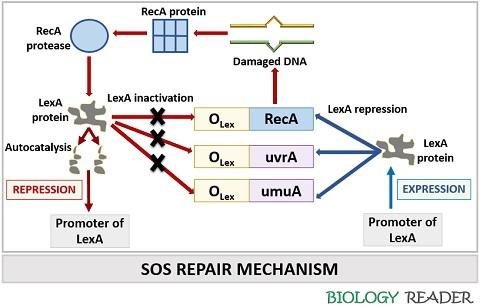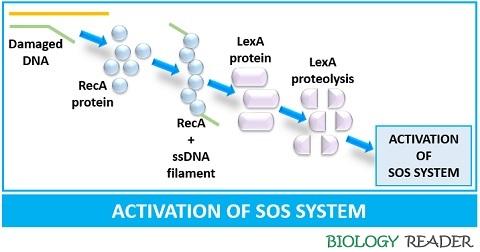SOS repair or “bypass” or “Emergency” repair is one of the DNA repair mechanisms introduced in 1975 by a scientist named Miroslav Radman. SOS repair primarily recovers the DNA damage caused due to environmental stresses. It serves as a regulatory system, which comprises many complex inducer proteins that repair the damaged DNA.
SOS system also includes a repressor protein, namely LexA. The RecA protein floats around the cell, which regulates the activity of LexA protein. The RecA regulatory protein mediates the repression or expression of LexA repressor.
“SOS response system” refers to the mechanism in which an organism initiates the production of activator protein (RecA), which results in the dissociation of LexA repressor and activates the SOS inducer proteins.
SOS repair system is an error-prone mechanism, as it works without a DNA template. In this context, we will discuss the definition, elements, principle of SOS repair along with the mechanism of SOS inactivation and activation.
Content: SOS Repair
Definition of SOS Repair
SOS repair refers to the DNA repair system, which uses RecA regulatory protein to inhibit the repressor’s activity and activate the SOS inducer genes to recover the DNA damage. It stands for “Save Our Soul”. The SOS system remains repressed until the conversion of RecA protein into RecA protease. It does not repair the DNA damage completely but provides tolerance ability to the affected organism.
 In normal DNA, a bacterial cell does not need DNA repair genes to be activated. Thus, there should be some controller that must control the expression of such genes. LexA acts as a repressor protein that binds to the particular site of DNA or SOS box. The binding will repress the activity of SOS genes.
In normal DNA, a bacterial cell does not need DNA repair genes to be activated. Thus, there should be some controller that must control the expression of such genes. LexA acts as a repressor protein that binds to the particular site of DNA or SOS box. The binding will repress the activity of SOS genes.
But in mutated DNA, the inactivation of LexA repressor becomes necessary to induce the expression of SOS genes. RecA acts as an activator of SOS genes in the SOS system, which causes proteolysis of the repressor protein and allows the SOS genes expression into different DNA repairing inducer proteins.
Elements
An SOS system composed of the following components:
- Regulator protein: It is encoded by the “RecA” gene, whose function is to activate the repressed SOS system by inhibiting the binding of LexA to the SOS operator.
- Repressor protein: It is encoded by the “LexA” gene, which causes the inactivation of inducer proteins. The repressor binds to the operator and causes inactivation or repression of the SOS system.
- Inducer proteins: They are encoded by SOS-box genes that can activate the inducer proteins relative to the type of DNA damage.
| SOS proteins | Encoded by | Functions |
|---|---|---|
| Regulatory protein | RecA gene | It functions as regulator of SOS system |
| Repressor protein | LexA gene | It functions as inhibitor of SOS system |
| Inducer proteins | uvrA gene | Repairs short patch nucleotide damage, cross-links and long patch nucleotide damage |
| uvrD gene | Repairs cross-links, Me-directed mismatches, double stranded gaps and short patch nucleotide damage | |
| umuC gene | It functions to bypass the lesion site of DNA and leads to mutagenesis | |
| umuD gene | It functions to bypass the lesion site of DNA and leads to mutagenesis | |
| ruv gene | Repairs recombinant DNA damage | |
| recN gene | Repairs recombinant DNA damage and gaps between double stranded DNA | |
| recQ gene | Repairs recombinant DNA damage | |
| dinA gene | It functions to bypass the lesion site of DNA and leads to alter the normal sequence of DNA | |
| sulA gene | It functions as an inhibitor of cell division |
Mechanism of SOS Repair
The mechanism of SOS repair is a complex cellular process mediated by the organism itself. It includes the following steps:

- In case of excessive DNA damage, stress conditions etc., a cell responds by activating signal or RecA protein. It floats in the vicinity of the cell in search of any damage in the DNA.
- A RecA protein specifically binds to the single stranded DNA. On binding with the single stranded DNA fragments, RecA forms a filament-like structure around the DNA.
- Then, a LexA repressor comes in contact with the nucleoprotein filament assembled by the RecA protein. When RecA interacts with the repressor protein, it converts into RecA protease.
- The formation of RecA protease causes autocatalytic proteolysis of LexA repressor protein. Thus, a LexA protein could not bind with the SOS operator.
- Inactivation of LexA protein activates the inducer proteins that repair the DNA damage but alters the DNA sequence.
- After DNA repair, the RecA protein loses its efficiency to cause proteolysis, and the LexA protein will again bind to the SOS operator or switch off the SOS system.
SOS Inactivation
An SOS system always switches off when a DNA is healthy. The LexA promoter produces LexA repressor protein. The association of LexA repressor to the consensus sequence (having 20 base pairs of the SOS-box) suppresses the functioning of the SOS system. Thus, LexA blocks the SOS box, which arrests the activity of SOS genes that participate in the recovery of damaged DNA.
SOS Activation
The SOS repair system comes into action when the DNA is not normal, and all the repair system fails. The organisms activate the SOS system by themselves in response to the damage against UV-light or any other factors.

SOS system only activates in case of excessive DNA damage, leading to single-strand breakage at the replication fork. This DNA damage activates the RecA regulatory protein that links with the single stranded DNA through the cellular energy ATP.
RecA protein and ssDNA attachment will give rise to a right-handed nucleoprotein complex or “RecA + ssDNA filament”. The interaction of LexA repressor with the nucleoprotein complex causes proteolytic cleavage of LexA dimer.
Proteolytic cleavage is due to the conversion of RecA protein into protease, which suppresses LexA protein’s activity. The SOS box genes will now express into different inducer proteins to recover the damaged DNA.
The expression of inducer proteins will not occur all at once but express relatively to the type of DNA damage. Therefore, an SOS system switches on and off in the presence and absence of activator RecA protein, respectively.
This is very useful to me